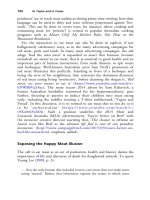The palgrave international handbook of a 239
Bạn đang xem bản rút gọn của tài liệu. Xem và tải ngay bản đầy đủ của tài liệu tại đây (48.33 KB, 1 trang )
234
J. Maher and T. Wyatt
Seidensticker’s (2010) study in 13 Asian tiger range countries found human
population growth (which doubled over 40 years) alongside significant
economic growth influenced tiger population decline and increased all
types of IWT offenders—poachers, smugglers and consumers. Consumers,
increasingly encouraged to own wildlife as status symbols, health remedies
and more, could look to a ready and accessible IWT market. Offenders,
willing to meet this demand, were substantially rewarded for tapping into the
IWT market in order to meet the needs of these new, wealthy consumers.
While economic motivations clearly influence the rational choice offender,
this is only one of a number of factors which can explain the abuse, as
discussed next.
Techniques of Neutralisation
In their study on poaching (not specifically for the IWT), Von Essen et al.
(2014) suggest offenders are motivated by a combination of livelihood (for
example, economic factors), folk (for example, custom and continuity) and
social (for example, political stance on regulation) factors. They suggest
neutralisation theory (Sykes and Matza 1957) is potentially the most
holistic explanation when looking beyond economically motivated factors
in understanding the abuse of wildlife. Neutralisation theory suggests five
ways in which offenders defend their behaviour and thereby minimise the
impact and consequences of their actions (Sykes and Matza 1957)—denial
of the victim, denial of injury, denial of responsibility, condemnation of the
condemners and appeal to higher loyalties—each of which is evident in the
legal and IWT.
Animals are seldom given victim status due to their inferior status in
society (Beirne 2009), furthermore, by focusing on ‘species’, the individual
animal victim is seldom recognised. The status conferred to wildlife (most
commonly as commodities, pests, products and objects of beauty/wonder) is
anthropocentric, fluid and often conflicting. For example, according to
CITES, elephants are an iconic species deserving of the greatest protection,
yet to indigenous farmers elephants are pests which require elimination
(Fernando et al. 2008). Even as protected species, their status is largely
linked to their commodified use as ivory. Sollund (2012) argues the denial
of injury to wildlife in the illegal trade is possible due to the accepted
systematic abuse in the legal trade, which is perceived to be necessary suffering.
Consequently, denial of responsibility for the harm caused by the trade is also
facilitated by the perception that some suffering is acceptable and thereby









